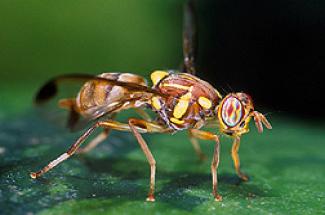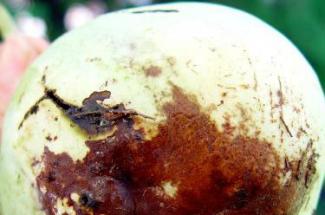Melon Fly
Catalogue Type
Plant Pests Catalogue
Scientific Name
Bactrocera cucurbitae
Family
Tephritidae
Distinguishing Characters
The adult melon fly is 6 to 8 mm in length. Distinctive characteristics include its wing pattern, its long third antennal segment, the reddish yellow dorsum of the thorax with light yellow markings, and the yellowish head with black spots.
The egg is elliptical, about 2 mm long, and pure white. It is almost flat on the ventral surface, and more convex on the dorsal. Eggs are often somewhat longitudinally curved.
The larva is a cylindrical-maggot shape, elongated, with the anterior end narrowed a somewhat curved ventrally. It has anterior mouth hooks, ventral fusiform areas and a flattened caudal end.
Last instar larvae range from 7.5 to 11.8 mm in length. The venter has fusiform areas on segments 2 through 11. The anterior buccal carinae are usually 18 to 20 in number. The anterior spiracles are slightly convex in lateral view, with relatively small tubules averaging 18 to 20 in number.
The puparium ranges in color from dull red or brownish yellow to dull white, and is about 5 to 6 mm in length.
The egg is elliptical, about 2 mm long, and pure white. It is almost flat on the ventral surface, and more convex on the dorsal. Eggs are often somewhat longitudinally curved.
The larva is a cylindrical-maggot shape, elongated, with the anterior end narrowed a somewhat curved ventrally. It has anterior mouth hooks, ventral fusiform areas and a flattened caudal end.
Last instar larvae range from 7.5 to 11.8 mm in length. The venter has fusiform areas on segments 2 through 11. The anterior buccal carinae are usually 18 to 20 in number. The anterior spiracles are slightly convex in lateral view, with relatively small tubules averaging 18 to 20 in number.
The puparium ranges in color from dull red or brownish yellow to dull white, and is about 5 to 6 mm in length.
Host Crop
Bittermelon, winter melon, cucumbers, eggplant, green beans, hyotan, luffa, melons, peppers, pumpkins, squashes, togan, tomatoes, watermelon, and zucchini.
Order
Diptera


